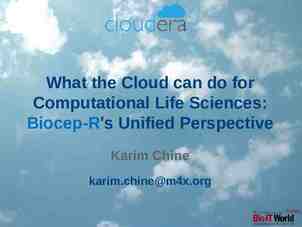Small Firm Knowledge Management Paul D. Callister, JD, MSLIS
15 Slides392.00 KB
Small Firm Knowledge Management Paul D. Callister, JD, MSLIS Director of the Leon E. Bloch Law Library & Associate Professor of Law UMKC School of Law
What is KM? Not Out-of-the-Box Software Not an Online Application Business Philosophy: The principle value of an organization is what (and who) it knows, not what it owns.
How does one measure the value of a law firm? How does one measure the value of a law firm? Not by the real estate, equipment or other tangible assets it owns. . . . Not by its individual lawyers -- they are constantly leaving or retiring, and new ones (hopefully) are constantly being added. Not even by its client roster. . . . Instead, the true value of a law firm is in its collective knowledge. Knowledge of the law, knowledge of its capabilities, knowledge of its client needs and of its competitors. A firm's effectiveness turns on how well its lawyers can bring their collective knowledge to bear in their client's behalf and how well the firm can use this knowledge to market its services. Rovner, J.R.(1999). Building the Smart Law Firm: Guidelines for Effective Management of Legal Knowledge Management. In Daily Journal Legal Works, The Technology Answer Show, Los Angeles 1999, Conference and Exhibition (pp. 133-138) Little Falls, NJ: Glasner Legal Works.
Four Enablers of KM Culture IT Technology Knowledge Infrastructure Measuring Impact
It’s About the Culture, Stupid! Not Technology Foster Sharing. Don’t tolerate attitudes of hoarding knowledge in order to increase one's influence. Lead by Doing. The support of the KM effort has to come from the top and not just with words, but with action, by "doing KM." Rely on the Twin Forces of Capitalism and Democracy. The emphasis here is on developing accountability. "Accountability drives the need for knowledge. When people need knowledge, they tend to trade it and share it." When billings and collections of attorneys are the only measurement of accountability in the firm, there will be KM problems. Develop Collaborative Relationships. Often projects can best be tackled by teams. Doing so has an additional advantage of forging relationships which later result in knowledge sharing. Instill Personal Responsibility for Knowledge Creation. Since people are the source of knowledge they have to have a responsible role in the system that manages it. Create a Collective Sense of Purpose. Collaborate on a firm mission statement. What is needed is something more than a common purpose based upon the desire to put food on the table and pay the mortgage. Somehow the strengths of the firm need to be articulated and become the basis for some realistic objective, which will become a part of our identity and sense of worth.
Information Technology – It’s Still Mostly About Culture! O'Dell and Grayson’s Rules of Thumb Investment in information technology ("IT") should constitute less than one-third of the KM system. "The more 'valuable' the knowledge, the less sophisticated the technology that supports it." "Tacit knowledge is best shared through people; explicit knowledge can be shared through machines. Or, the more tacit the knowledge, the less high-tech the solution.“ O'Dell, C. & Grayson, C.J., Jr. (1998). If Only We Knew What We Know: The Transfer of Internal Knowledge and Best Practice. New York, NY: The Free Press, p. 81, 88
Information Technology – Distinguishing Between High Grade and Low Grade Knowledge Tacit (High Grad) Knowledge - The KM design for the firm must place a heavy emphasis on non-technological solutions, such as informal lunches with training presentations and the creation of teams to tackle document production standards, organize document libraries, and create training standards and programs. Low Grade Knowledge - The highest technological tools ought properly to be reserved for electronic document searches, with the corresponding recognition that such documents represent a "lower grade" of knowledge. Indeed such efforts, really constitute information management rather than knowledge management.
Information Infrastructure - Designing Document Libraries Every item of information you can envision adding to the system fits comfortably into one of your categories or subcategories; Every list of items within a subcategory is mutually exclusive (i.e., no item on the list would fit equally well in another subcategory's list) and collectively exhaustive (i.e., the list is complete); The user can navigate to any item of information with three or fewer mouse clicks, regardless of the starting point; The user can navigate to any item on a list with little or no scrolling. Rovner, J.R.(1999). Building the Smart Law Firm: Guidelines for Effective Management of Legal Knowledge Management. In Daily Journal Legal Works, The Technology Answer Show, Los Angeles 1999, Conference and Exhibition (p. 135) Little Falls, NJ: Glasner Legal Works.
Knowledge Infrastructure - Barriers to Knowledge Transfer Hidden knowledge--people don't realize that what they know is valuable to others. Blindness--people who need knowledge don't realize they need it. Locked up tacit knowledge--the knowledge which is really valuable, coming from experience, intuition, is often difficult to express and codify and remains locked behind the eyes and ears of its source. "We're different" blinders--The false belief that potentially valuable knowledge cannot be transferred because the potential recipients have focused on differences, rather than similarities of a process or way of doing things. "Sorry--I'm too busy"--there is no time to invest in saving time. This is the classic modus operandi of the firm. Implementation is hard--KM remains unrealized because of lack of funding, fear of change, lack of leadership and training, etc. See O'Dell, C. & Grayson, C.J., Jr. (1998). If Only We Knew What We Know: The Transfer of Internal Knowledge and Best Practice (pp. 108-109). New York, NY: The Free Press.
Addressing The Barriers Approach Descriptive Words Self-Directed Storage, codification, repository, database, retrieval, navigation, pointers, yellow pages, dissemination, intranets, Internet Knowledge Information services, help desk, Services and networks, discussion databases, Networks communities of practice, knowledge managers, knowledge integrators, knowledge packagers, want ads Facilitated Facilitators, change agents, Transfer implementers, projects, technical assistance, consultants, guidance counselors, support personnel, brokers, coaches, shepherds Problems Addressed Blindness Hidden knowledge, blindness, tacit knowledge, we're different Level of Resources Required Low Medium Hidden High knowledge, blindness, tacit knowledge, we're different, too busy, implementation O'Dell, C. & Grayson, C.J., Jr. (1998). If Only We Knew What We Know: The Transfer of Internal Knowledge and Best Practice (pp. 112-122). New York, NY: The Free Press.
Measuring Impact (Benchmarks) Stock Price (N/A) Performance Improvement (Possible Measures) – Number of documents drafted in a month – Numbers of particular kinds of documents (trusts, corporations, retirement plans, amendments, buy-sell agreements) – Time required to prepare such documents, – Number of hits to the firm bulletin board and master document library – Secretarial overtime and hours, and compare that against the number and size (measured in pages or bytes) of documents produced each month – Utilization of work-flow software might suggest additional measurements such as the number of projects taking longer then 10, 30, 60, and 90 days, etc. to complete Cost of Not Knowing ("CONK") – Malpractice suits? – Complaint file – Lost clients See O'Dell, C. & Grayson, C.J., Jr. (1998). If Only We Knew What We Know: The Transfer of Internal Knowledge and Best Practice (pp. 127-129). New York, NY: The Free Press.
KM – Trend or Legitimate Management Philosophy? As an internationally recognized consultant on the issues of KM and computer system applications in business, META Group has been skeptical of KM trends. However, it has ultimately supported the theory as having merit so long as the application of KM is narrowly focused and contained within the larger context of management theory. Organizations that have successfully exploited KM opportunities have done so by applying KM practices and technologies against specific business process pain points and in the context of specific knowledge worker (KW) needs. This is why generic, enterprise-wide KM typically fail (vague goals, ill-defined benefits, unclear user motivation to participate, while targeted implementations (define collaborative R&D needs and deploy applications to support them) are more likely to succeed. META Group, Electronic Business Strategies (1999, April 27). Knowledge Management (KM) is Dead Long Live KM (File No. 800). Stamford, CT: META Group Inc.
Recommended Reading Botkin, J. (1999). Smart Business: How Knowledge Communities can Revolutionize Your Company (p.162). New York, NY: The Free Press. Burchard, B. (1999, October). Intangible Assets Hard Numbers Soft Finance. Fast Company. Harvard Business Review On Knowledge Management (1998). Boston, MA: Harvard Business Review Paperback. Rovner, J.R.(1999). Building the Smart Law Firm: Guidelines for Effective Management of Legal Knowledge Management. In Daily Journal Legal Works, The Technology Answer Show, Los Angeles 1999, Conference and Exhibition. Little Falls, NJ: Glasner Legal Works. O'Dell, C. & Grayson, C.J., Jr. (1998). If Only We Knew What We Know: The Transfer of Internal Knowledge and Best Practice. New York, NY: The Free Press.
Recommended Reading
The End Return to Small Firm Resources Site




















